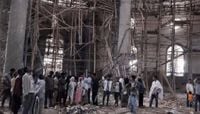In the early hours of October 1, 2025, tragedy struck the tight-knit community of Arerti, Ethiopia, as makeshift scaffolding at the Menjar Shenkora Arerti Mariam Church collapsed during an annual religious festival, leaving at least 36 people dead and more than 200 injured. The disaster unfolded as thousands of Orthodox Christian worshippers gathered to mark the feast of St. Mary, a day typically filled with celebration and prayer, but which this year descended into chaos and heartbreak.
The collapse occurred around 7:45 am, according to state media and local officials, as worshippers—many of whom had climbed the wooden scaffolding to glimpse a ceiling mural—were suddenly plunged into panic. "We all had gathered in prayers when all of a sudden the scaffolding collapsed and people starting falling from the ceiling," recalled Mikias Mebratu, a witness who lost three friends in the disaster, as reported by BBC. The sound of the structure giving way was, by all accounts, deafening and terrifying, sending people scattering in desperate attempts to escape the falling debris.
Images broadcast by the Ethiopian Broadcasting Corporation (EBC) and shared on social media painted a grim picture: collapsed wooden poles tangled amid dense debris, shoes scattered across the church floor, and crowds of shocked onlookers searching for loved ones. The Menjar Shenkora Arerti Mariam Church, located about 70 kilometers east of Addis Ababa in the Amhara region, had been under construction, with makeshift scaffolding supporting part of the structure. The church, a focal point for the local community and a symbol of Ethiopia’s deep-rooted Christian heritage, was transformed in an instant from a place of worship to the site of one of the nation’s most devastating recent accidents.
District police chief Ahmed Gebeyehu told state media Fana, "The number of dead has reached 36 and could increase," adding that more than 200 people had suffered injuries and were receiving treatment at a local hospital. The victims ranged from young adults to the elderly, and included children. Seyoum Altaye, a clinician at a nearby hospital, confirmed, "So far we have over a hundred injured, including children and the elderly. We are seeking urgent support from the Red Cross." At his facility alone, 25 deaths had already been confirmed by the afternoon.
Rescue operations began immediately and continued into the afternoon, with many people believed to be still trapped under the rubble. Local official Atnafu Abate told the Ethiopian Broadcasting Corporation that some of the more seriously injured were taken to hospitals in Addis Ababa, the nation’s capital. The true scale of the tragedy, however, remained uncertain as authorities and volunteers worked tirelessly to find survivors. "Some people remained under the rubble," Atnafu Abate said, declining to provide further details about those still trapped or the progress of rescue efforts.
For the people of Minjar Shenkora and the wider Ethiopian Orthodox community, the disaster struck at the heart of one of their holiest days. "This is a day we should have been celebrating together," one worshipper told BBC. "Instead, we are grieving." The annual feast of St. Mary draws thousands of pilgrims from across the region, many of whom travel for hours or even days to attend. The event is typically marked by vibrant processions, communal prayers, and a spirit of unity—now replaced by mourning and uncertainty.
Local administrator Teshale Tilahun described the collapse as "a tragic loss for the community," warning that the number of casualties could rise further as rescue operations continued. The mood in Arerti was somber, with families searching hospitals and the disaster site for news of missing relatives. The Red Cross and other aid organizations were called in to provide medical support and help coordinate the emergency response.
The Ethiopian government expressed its "deep condolences for the damage caused by the collapse" in a statement broadcast by the state-run Ethiopian Broadcasting Corporation. Officials emphasized the urgent need to enforce safety standards on all construction projects, a message underscored by longstanding concerns about weak regulation in Ethiopia’s booming building sector. The country, Africa’s second most populous nation, has seen rapid urban development in recent years, but health and safety regulations remain virtually non-existent—a reality that has contributed to frequent construction accidents, according to South China Morning Post.
Indeed, the precarious nature of the scaffolding at the Menjar Shenkora Arerti Mariam Church was evident in images released after the collapse. Wooden poles, lashed together in makeshift fashion, supported the partially constructed roof—a common sight in Ethiopia, where building codes are often ignored or unenforced. The tragedy has reignited debate about the need for stricter oversight and better practices in the construction industry, especially for structures intended to host large public gatherings.
Despite the government’s pledge to improve safety standards, for the people of Arerti and the families of those lost, such assurances come too late. The focus now is on mourning, recovery, and supporting the injured. "It is a tragic loss for the community," local administrator Teshale Tilahun reiterated, a sentiment echoed by officials, medical workers, and everyday citizens alike.
As Ethiopia processes the shock of this disaster, the story of the Menjar Shenkora Arerti Mariam Church collapse serves as a stark reminder of the human cost of inadequate safety measures and the fragility of life, even amid moments of faith and celebration. The hope among many is that the lessons learned from this tragedy will spur real change—so that future gatherings, whether for worship or any other purpose, will be marked by joy and not by grief.





